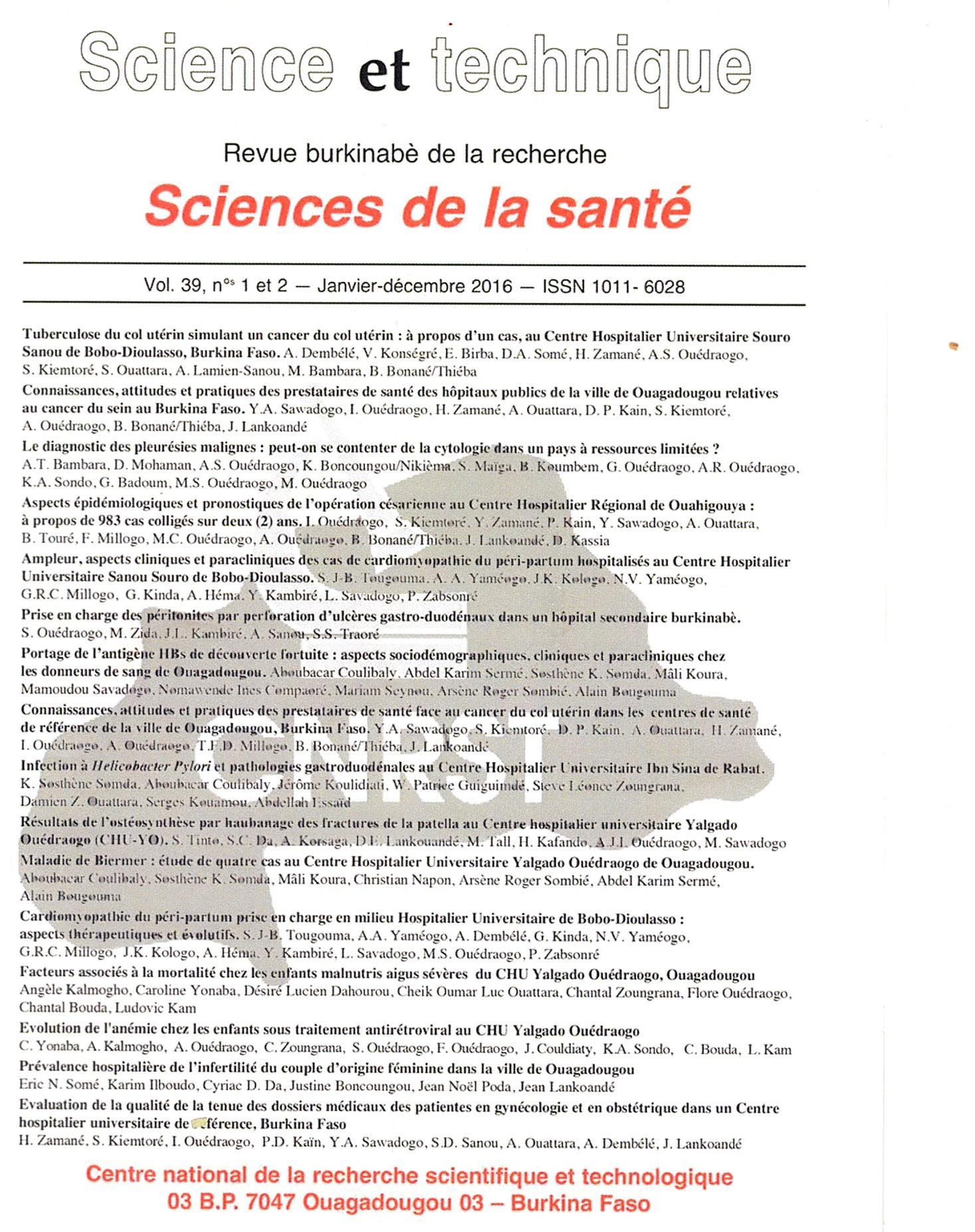Evolution de l'anémie chez les enfants sous traitement antirétroviral au CHU Yalgado Ouédraogo
Mots-clés :
VIH, ARY, Enfants, Anémie, Evolution, Burkina FasoRésumé
Français
Au cours de l'infection à VIH, la fréquence élevée de l'anémie est fonction de l'évolution de la maladie. L'objectif de notre étude était de décrire l'évolution de l'anémie chez les enfants infectés par VIH au cours du traitement antirétroviral dans le département de pédiatrie du Centre Hospitalier Universitaire Yalgado Ouédraogo. Il s'est agi d'une étude rétrospective, descriptive et analytique chez les enfants infectés par le VIH sous TARV de juin 2005 à juillet 2013. Tous les enfants infectés par le VIH, ayant bénéficié d'un hémogramme à l'initiation (MO) à 6 mois (M6) et à 12 mois (M 12) du traitement antirétroviral ont été inclus. Pour l'analyse, nous avons utilisé le test de khi-deux ou le test de Fischer. En outre, le test de normalité de Kolmogorov-Smimov a été utilisé pour vérifier la normalité des taux moyens d'hémoglobine. Le seuil de significativité retenu était de 5 %. Cent-huit patients ont été inclus. A l'inclusion, J'anémie était présente chez 94 enfants (87 %). Elle était modérée chez 65 %, normochrome normocytaire chez 56 % et hypochrome microcytaire chez 44 %. Sur le plan évolutif, à M6 et M12, l'anémie était présente respectivement chez 75 (69,4 %) et 66 (61 %) enfants. Notons qu'à Ml2, elle était modérée chez 57,6 % et normochrome normocytaire chez 85 % des enfants. En outre, le gain moyen d'hémoglobine était de 1,21 g/dl à 6 mois (p < 0,00 1) et de 1,57 g/dl à 12 mois (p < 0,00 l). La prescription du fer à l'initiation du traitement ARV n'était pas statistiquement associée à l'absence de l'anémie à M6. La fréquence de l'anémie diminuait chez les enfants sous traitement anti rétroviral au cours de suivi. Devant une anémie chez un enfant infecté par le VIH, la prescription du fer ne doit pas être systématique mais doit être orientée par l'analyse de l'hémogramme et les autres examens complémentaires.
Anglais
In the context of HIV, the high incidence of anemia depends on the stage of the disease. The aim of the study was to describe the outcome of anemia in HIV infected children on ART in the Department of Pediatrics, University Hospital Yalgado Ouédraogo. It was a descriptive and analytical retrospective study in HIV infected children on ART in the pediatric department of Yalgado Ouédraogo from June 2005 to July 20 13. Ail HIV infected children who had a blood count at initiation (MO), 6 months (M 6) and 12 months (MJ 2) of antiretroviral therapy were enrolled. Statistical tests used were x2, fisher's and Kolmogorov-Smirnov tests. Anemia was present in 94 children (87%). It was moderate in 65%, normochromic normocytic in 56% and hypochromic microcytic in 44%. At M6 and M l2 of follow up, anemia was present respectively in 75 (69.4%) and 66 (61%) children. Note that at M l2, it was moderate in 57.6% and normochromie normocytic in 85% of children. In addition, the mean hemoglobin level increased from 9.4 g/dl (3,7 l 2.7 g/dl) at baseline to 10,9 gIdl (7,9 13.8 gIdl) at M l2 . Iron supplement al baseline was not statistically associated with the absence of anemia at M6 of follow up. The frequency of anemia decreased in HIV infected children on ART. The prescription of iron should not be systematic in HIV infected children presenting anemia, but must be guided by the blood count analysis and other complementary tests.

